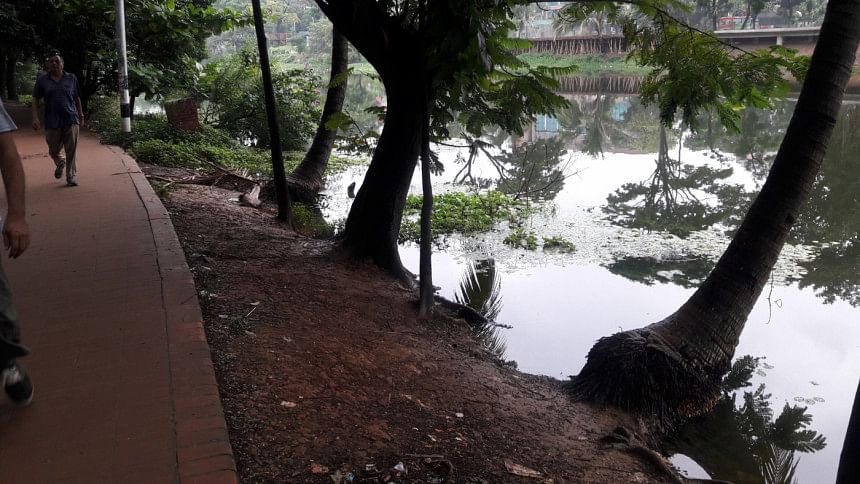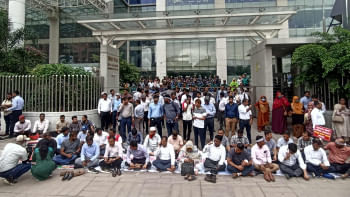Saving Dhanmondi Lake

The Dhanmondi lake deserves some serious attention by the relevant authorities to save it from pollution. Dhanmondi's development began as early as the mid-1950s: the entire area was built on 240.74 ha of land of which the lake covers 37 ha or about 16 percent of the residential area. The lake, which is an essential part of the Dhanmondi residential area, is 3 km in length and between 35 and 100 metres in width.
The lake side is dotted with large trees providing shade to the passers-by for the last six decades. A park and a walkway along the lake added extra beauty to the area. Several small restaurants have been allowed to operate inside the park. There are also four public toilets in the area.
The lake is not managed by a single authority, but by five different government entities looking after its various facilities. The Ministry of Works has formal ownership of the lake; the Fisheries Department looks after fishery development; the Ministry of Local Government, Rural Development and Cooperatives and Dhaka South City Corporation undertake development works and look after its maintenance. The Department of Environment (DOE) takes care of the environmental aspects and protection of aquatic resources of the lake.
The Dhanmondi lake, park and the walkway have been revamped through two government development projects in the recent past. The last project was implemented between 2011 and 2013. Before that, improvement work of the lake was carried out from 1998 to 2001. Through these projects, the lake was cleaned and re-excavated. These projects also built small overbridges, drains, public toilets, street lights, planted trees, installed iron fencing and built walkways and public toilets.
According to the residents of Dhanomndi, the quality of water of Dhanmondi lake has deteriorated over the last few years. They have seen the fish stock dwindle to a minimum. Fishing used to be a popular recreational activity among the inhabitants of the area; but it is no more, thanks to the limited number of fish in the lake. The water has turned green and emits a foul smell. A couple of studies on the lake have suggested that the quality of water is very poor and it is no longer habitable for fish.
Over the last six years, the condition of the infrastructure around the lake has also deteriorated. The walkways have developed cracks and subsided in several places due to overflowing of lake water during the rainy season. Rain has also damaged the lake's slope as there is no protection wall, and iron fencing has fallen apart in several parts of the lake area.
One of the main attractions of Dhanmondi area is the Bangabandhu Memorial Museum on Road 32. A large number of people from different parts of the country visit the museum on a regular basis. The heads of states and foreign dignitaries also visit the museum to show respect to the Father of the Nation when they visit Bangladesh. Thousands of people also inhabit the surrounding areas every day for a walk, and many of them also use it as a socialising spot: they meet up with friends, gossip over a cup of tea and snacks.
Taking advantage of the large number of visitors, many tea and snack stalls have mushroomed in the area and hawkers are selling ground nuts, fruits, vegetables and ice-cream. The cleaners struggle to keep the area clean as there are very few dustbins in the area. Empty food packets, ground nut shells, used soft drink and water bottles and plastic bags litter the whole area. Since the number of garbage bins is limited, the visitors throw away a significant volume of garbage into the lake.
The bed of the lake is rising due to this and water pollution is worsening, which needs to be looked at on a priority basis. The only public toilet on Road 32 is inadequate for the large number of people visiting the area. Therefore, people are seen urinating and defecating on the lake side every now and then. While there is iron fencing in other parts of Dhanmondi area to protect the lake, there is no fencing on Road 32; thus people take the liberty to answer nature's call on the lake side.
The few remaining plants along this road are being damaged by the people who enter the lake side easily since there is no iron fencing along this road. The plants are also dying because of the heat produced by the gas stoves used for cooking snacks and tea. The locals are worried about the deterioration of the environment of the area, specially because the Bangabandhu Memorial Museum is situated there and thus the area should be more strictly protected. Colourful plants and flowers should be planted and well maintained.
The Public Works Department and the City Corporation are expected to divide the responsibility to maintain the area as a model neighbourhood. All the sources of the lake's pollution should be identified, including any sewerage pipe entering the lake and polluting water. These should be immediately removed, garbage bins should be installed and the public should stop throwing garbage into the lake. The lake bed should be cleaned up and lake water treated. Earth filling is also needed to raise the land level in some places.
The responsibility of keeping Dhanmondi lake clean falls on the shoulders of the relevant authorities as well as the people who visit the area every day: the pedestrians, the vendors, the hawkers, and the guards and cleaners of the lake who should do a better job of keeping the area clean. The government should seek expert advice on how the lake water can be treated and it can be made fish friendly. Some locals plant trees and clean the garbage in the area on a voluntary basis; but individual efforts are not enough. The concerned authorities must now come forward to preserve the lake.
Dr Nawshad Ahmed is an economist and urban planner. He worked previously as a UN official in Bangladesh and abroad.

 For all latest news, follow The Daily Star's Google News channel.
For all latest news, follow The Daily Star's Google News channel. 



Comments